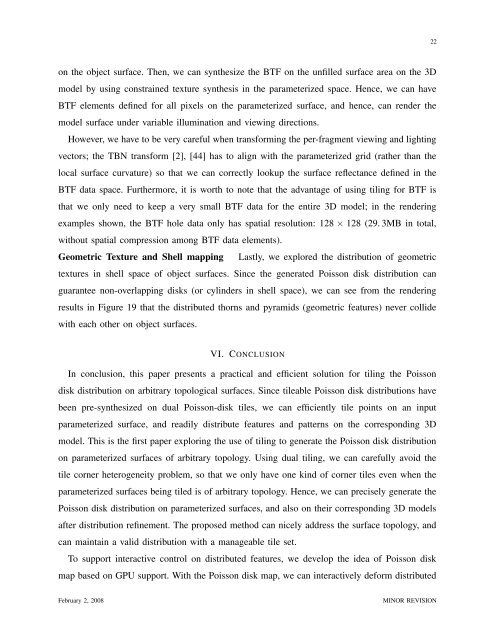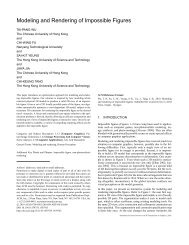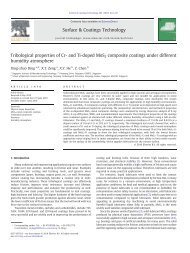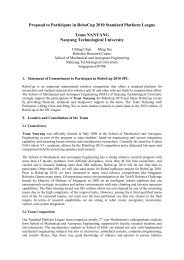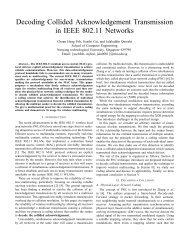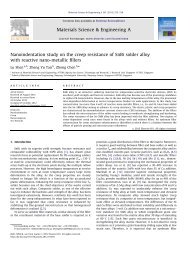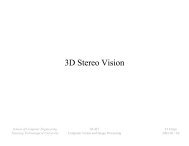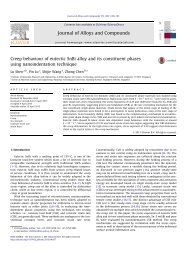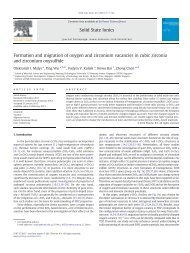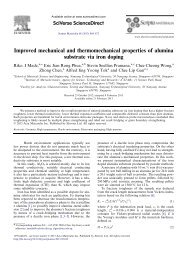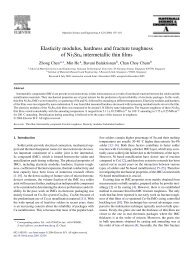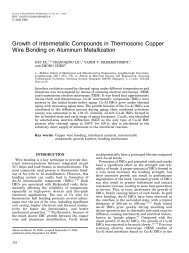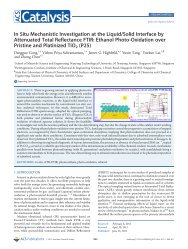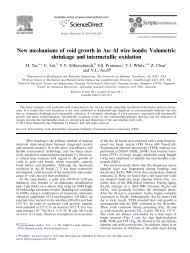ptdist - Nanyang Technological University
ptdist - Nanyang Technological University
ptdist - Nanyang Technological University
You also want an ePaper? Increase the reach of your titles
YUMPU automatically turns print PDFs into web optimized ePapers that Google loves.
on the object surface. Then, we can synthesize the BTF on the unfilled surface area on the 3D<br />
model by using constrained texture synthesis in the parameterized space. Hence, we can have<br />
BTF elements defined for all pixels on the parameterized surface, and hence, can render the<br />
model surface under variable illumination and viewing directions.<br />
However, we have to be very careful when transforming the per-fragment viewing and lighting<br />
vectors; the TBN transform [2], [44] has to align with the parameterized grid (rather than the<br />
local surface curvature) so that we can correctly lookup the surface reflectance defined in the<br />
BTF data space. Furthermore, it is worth to note that the advantage of using tiling for BTF is<br />
that we only need to keep a very small BTF data for the entire 3D model; in the rendering<br />
examples shown, the BTF hole data only has spatial resolution: 128 × 128 (29. 3MB in total,<br />
without spatial compression among BTF data elements).<br />
Geometric Texture and Shell mapping Lastly, we explored the distribution of geometric<br />
textures in shell space of object surfaces. Since the generated Poisson disk distribution can<br />
guarantee non-overlapping disks (or cylinders in shell space), we can see from the rendering<br />
results in Figure 19 that the distributed thorns and pyramids (geometric features) never collide<br />
with each other on object surfaces.<br />
VI. CONCLUSION<br />
In conclusion, this paper presents a practical and efficient solution for tiling the Poisson<br />
disk distribution on arbitrary topological surfaces. Since tileable Poisson disk distributions have<br />
been pre-synthesized on dual Poisson-disk tiles, we can efficiently tile points on an input<br />
parameterized surface, and readily distribute features and patterns on the corresponding 3D<br />
model. This is the first paper exploring the use of tiling to generate the Poisson disk distribution<br />
on parameterized surfaces of arbitrary topology. Using dual tiling, we can carefully avoid the<br />
tile corner heterogeneity problem, so that we only have one kind of corner tiles even when the<br />
parameterized surfaces being tiled is of arbitrary topology. Hence, we can precisely generate the<br />
Poisson disk distribution on parameterized surfaces, and also on their corresponding 3D models<br />
after distribution refinement. The proposed method can nicely address the surface topology, and<br />
can maintain a valid distribution with a manageable tile set.<br />
To support interactive control on distributed features, we develop the idea of Poisson disk<br />
map based on GPU support. With the Poisson disk map, we can interactively deform distributed<br />
February 2, 2008 MINOR REVISION<br />
22


